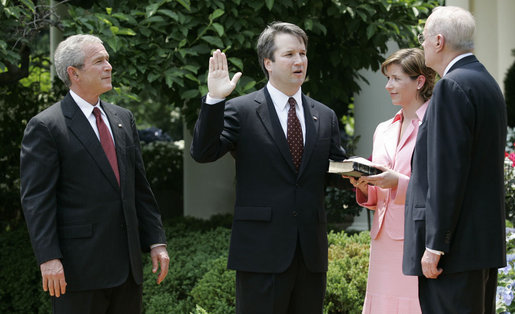Brett Kavanaugh and the Starr Report: How Our Office Drafted the Impeachment Referral
Twenty years ago, Brett Kavanaugh and I were on the team that drafted Kenneth Starr’s impeachment referral. Here’s what the Supreme Court nominee did and did not do.

Published by The Lawfare Institute
in Cooperation With

Under independent counsel Kenneth W. Starr in 1998, I helped draft what came to be known as the Starr Report: a summary of “substantial and credible information ... that may constitute grounds for an impeachment,” which 28 U.S.C. § 595(c) then required us to send to the House of Representatives. One of my colleagues in that endeavor was Brett Kavanaugh, the D.C. Circuit judge President Trump has nominated to the Supreme Court.
Over the past few days, a number of journalists have asked me about differences with Brett while we worked on the report. I thought it would be useful to spell out what role Brett played, what role he did not play and where disagreements arose.
The Starr Report was the product of an office. It didn’t represent the individual views of any one staffer. Nor did it have a single drafter. Andy Leipold principally drafted the introduction; Craig Lerner and I were the principal authors of the factual overview; and Brett drafted the outline of acts that potentially constituted grounds for impeachment. I don’t want to overstate this division of labor. Everyone in the office worked to some degree on all parts of the referral, as we called it. But broadly speaking, it’s fair to summarize the division by saying that the presentation of law in the impeachment counts of the document is mainly Brett’s prose; the presentation of facts in the narrative is not. When disagreements arose, final decisions ultimately were Ken’s. And once he had made a decision, on the referral or anything else, we all set aside any disagreements and implemented that decision.
Congress apparently modeled Section 595(c) on Watergate Special Prosecutor Leon Jaworski’s transmittal of evidence to the House Judiciary Committee in 1974. The House was already at work then on impeaching President Richard Nixon. In fact, the Judiciary Committee made a point of stressing the exclusivity of the House’s constitutional role. The committee opted not to seek judicial enforcement of its subpoenas to the White House, on the ground that the Constitution assigns the task of impeachment solely to the House, with no role for the courts. In 1998, by contrast, Judiciary Committee Chair Henry Hyde said that the House wouldn’t start an impeachment inquiry before receiving a report from the independent counsel. As a result, we were in the position of having to predict what the House might consider legitimate grounds for impeachment.
Brett and I disagreed about two issues in the course of preparing the referral, only one of which I was aware of at the time. The first was whether to include a factual overview.
In the course of drafting the referral, we tried several structures. Initially, it looked as though most of the intimate details could be relegated to an appendix. We would emphasize that the appendix never ought to be released, even if the House ended up releasing other parts of the document. Increasingly, though, it became apparent that the evidence needed to be seen as a whole, so we abandoned this structure.
Early drafts summarized the evidence in support of each potentially impeachable act, one by one—perjury, obstruction of justice and so on. This structure required recapitulating many facts time after time, especially facts about the relationship between President Bill Clinton and Monica Lewinsky. To avoid the repetition, we decided to open with a narrative overview of the facts, presented in chronological order, followed by the outline of possible impeachment counts.
In my opinion, the details—whether in a chronological summary, in separate impeachment counts or in an appendix—were indispensable for two reasons. First, they corroborated Lewinsky’s credibility. She remembered many details; she did so consistently over time; and her recollections matched up with White House records and other evidence.
Second, some sexually explicit details were essential to demonstrate that the president had lied under oath when, in his deposition in the Paula Jones case, he denied having had “sexual relations” with Lewinsky. “Sexual relations” had a precise definition for purposes of the case. The president came up with a famously strained interpretation when he testified before the grand jury. But Lewinsky consistently testified that their activities constituted sexual relations even under his interpretation. The president’s false testimony couldn’t be explained without reference to the intimate details. That’s why they appear in the narrative overview and in the first two potential impeachment counts.
The level of detail made privacy a concern, of course, but our audience—we thought—would be small. The referral would merely supply guidance if the House decided to open an impeachment inquiry. When working on the referral, in fact, I asked the National Archives about Jaworski’s Watergate report to the House. The archivist told me it was still under seal.
Unfortunately, the House in 1998 ended up taking a different path. Members voted, 363 to 63, to post the referral online before any of them had read it. According to “The Breach,” by Peter Baker, House Speaker Newt Gingrich favored its immediate release because (in Baker’s words) “[i]f they reviewed the report before releasing it ... they would take political ownership of its content.”
Later, I learned that Brett had urged Ken, unsuccessfully, to excise the factual summary from the report, on the ground that it was excessively explicit. I found out about this in 1999, when I read Bob Woodward’s book “Shadow.”
The second issue on which we differed was whether to urge the House not to release the report. Brett actually drafted a letter to this effect. I argued against sending it. I believed, first, that it might suggest a sudden loss of confidence in our work; and, second, that having transmitted the referral and the supporting evidence we ought to stay offstage. After hearing the arguments on both sides, Ken decided against sending the letter.
Twenty years later, I think I was right about the first question—whether to include the factual details—and Brett was right about the second question: whether to urge the House to behave with discretion. In any event, the referral as a whole reflects everyone’s input and Ken Starr’s final decisions.




